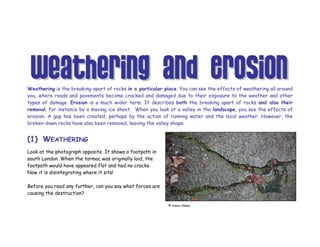More Related Content
Similar to Glacial erosion and weathering
Similar to Glacial erosion and weathering (20)
More from Bourne Grammar School
More from Bourne Grammar School (12)
Glacial erosion and weathering
- 1. Weathering is the breaking-apart of rocks in a particular place. You can see the effects of weathering all around
you, where roads and pavements become cracked and damaged due to their exposure to the weather and other
types of damage. Erosion is a much wider term. It describes both the breaking apart of rocks and also their
removal, for instance by a moving ice sheet. When you look at a valley in the landscape, you see the effects of
erosion. A gap has been created, perhaps by the action of running water and the local weather. However, the
broken-down rocks have also been removed, leaving the valley shape.
(1) WEATHERING
Look at the photograph opposite. It shows a footpath in
south London. When the tarmac was originally laid, the
footpath would have appeared flat and had no cracks.
Now it is disintegrating where it sits!
Before you read any further, can you say what forces are
causing the destruction?
© Simon Oakes
- 2. The footpath is weathering due to many different factors or causes:
Rainwater freezes at night in small hair-line cracks and widens them. Water expands by 10% when it freezes to
form ice. Over time, cracks get wider and wider
Daytime, night-time and seasonal temperature changes cause minerals in the tarmac to expand and contract as
they are heated and cooled - which can be very damaging
Rainwater contains mild acids that can dissolve some minerals over long periods of time
Tree roots are growing underneath the tarmac and they break it apart. This is biological weathering
Humans walk on the path every day and their trampling damages it
(2) ICE EROSION
Erosion involves the break-down of rock and its removal by a
moving force like ice or water. Look at the photograph
opposite. The needles of rock are all that remains of a
highland area that has been attacked by ice.
As it moves downhill, ice not only helps break apart the rock
beneath, it also transports the broken-down material into
lowland areas.
© Bruce Herrod/Royal Geographical Society
- 3. In the photograph below, you can see an enormous glacier moving down a slope under gravity. All that is left either
side are the very toughest parts of a highland area that have so far survived the ice’s attack!
HOW IT WORKS…
As the ice moves over a rock surface, it freezes
around loose or weak sections, pulling them
away. This is called plucking. Once pieces of
jagged rock are being carried by the ice, they
have a ‘sandpaper effect’ on other land
surfaces, helping to cause further destruction.
This is called abrasion.
© Trevor Cole
ACTIVITY Ice is not the only agent of erosion found in the natural world. Water
and wind are also important agents of erosion.
•
•
•
What types of physical environment do you associate with (i) water and (ii) strong winds? Where are they found?
How do you think water and wind help with (i) the break-down of rocks and (ii) the movement of sands and gravels?
What kind of landforms and landscapes do you think result from water and wind erosion?
Tip: if you have access to the internet, try googling ‘water erosion’ ‘wind erosion’ ‘sea cliffs’ and ‘sand dunes’ to get you
started. You can select ‘image search’ within Google to call up pictures. Also remember to ask your geography teacher
for an atlas to help you get started.

